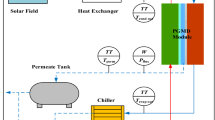Abstract
Nowadays, membrane distillation (MD) systems have found considerable attention in separation processes, especially for desalination applications. Among different MD systems, air gap membrane distillation (AGMD) system is of the most appropriate choices for water desalination. In this system, the stagnant air gap between the membrane and condensation surface causes an increase in the thermal energy efficiency of the process. To understand the relationships between input and outputs parameters and variables, a mathematical technique was developed using Volterra functional series theory. The cold feed inlet temperature (T 1), hot feed inlet temperature (T 3), and feed-in flow rate (F) were considered as the input variables of the AGMD system, and distillate flux (J), cold feed outlet temperature (T 2), and gained output ratio (GOR) were set as the output variables. The relationships between these variables were examined, and their effect on the performance of the AGMD system was evaluated in terms of GOR and J by using the presented mathematical techniques of multivariable function approximation. A particle swarm optimization-based controlled neural network was also performed to explore the effect of input operational parameters on GOR, J, and T2 in each model to determine the existence domain of model coefficients. The experimental data have been collected from the literature and analyzed to check the consistency and accuracy of proposed model. It was found that the presented models can reproduce the available experimental data with desirable accuracy.

Similar content being viewed by others
References
Hou D, Wang Z, Li G, Fan H, Wang J, Huang H (2015) Ultrasonic assisted direct contact membrane distillation hybrid process for membrane scaling mitigation. Desalination 375:33–39. doi:10.1016/j.desal.2015.07.018
Chen Z, Rana D, Matsuura T, Meng D, Lan CQ (2015) Study on structure and vacuum membrane distillation performance of PVDF membranes: II. Influence of molecular weight. Chem Eng J 276:174–184. doi:10.1016/j.cej.2015.04.030
Kezia K, Lee J, Weeks M, Kentish S (2015) Direct contact membrane distillation for the concentration of saline dairy effluent. Water Res 81:167–177. doi:10.1016/j.watres.2015.05.042
Nakoa K, Rahaoui K, Date A, Akbarzadeh A (2015) An experimental review on coupling of solar pond with membrane distillation. Sol Energy 119:319–331. doi:10.1016/j.solener.2015.06.010
Shukla S, Benes NE, Vankelecom I, Méricq JP, Belleville MP, Hengl N, Marcano JS (2015) Sweep gas membrane distillation in a membrane contactor with metallic hollow-fibers. J Membr Sci 493:167–178. doi:10.1016/j.memsci.2015.06.040
Xiao T, Wang P, Yang X, Cai X, Lu J (2015) Fabrication and characterization of novel asymmetric polyvinylidene fluoride (PVDF) membranes by the nonsolvent thermally induced phase separation (NTIPS) method for membrane distillation applications. J Membr Sci 489:160–174. doi:10.1016/j.memsci.2015.03.081
Wang P, Cui Y, Ge Q, Fern Tew T, Chung T-S (2015) Evaluation of hydroacid complex in the forward osmosis–membrane distillation (FO–MD) system for desalination. J Membr Sci 494:1–7. doi:10.1016/j.memsci.2015.07.022
Zhu J, Jiang L, Matsuura T (2015) New insights into fabrication of hydrophobic/hydrophilic composite hollow fibers for direct contact membrane distillation. Chem Eng Sci 137:79–90. doi:10.1016/j.ces.2015.05.064
Efome JE, Baghbanzadeh M, Rana D, Matsuura T, Lan CQ (2015) Effects of superhydrophobic SiO2 nanoparticles on the performance of PVDF flat sheet membranes for vacuum membrane distillation. Desalination 373:47–57. doi:10.1016/j.desal.2015.07.002
Duong HC, Cooper P, Nelemans B, Cath TY, Nghiem LD (2015) Optimising thermal efficiency of direct contact membrane distillation by brine recycling for small-scale seawater desalination. Desalination 374:1–9. doi:10.1016/j.desal.2015.07.009
Pangarkar BL, Deshmukh SK (2015) Theoretical and experimental analysis of multi-effect air gap membrane distillation process (ME-AGMD). J Environ Chem Eng 3(3):2127–2135. doi:10.1016/j.jece.2015.07.017
He Q, Li P, Geng H, Zhang C, Wang J, Chang H (2014) Modeling and optimization of air gap membrane distillation system for desalination. Desalination 354:68–75. doi:10.1016/j.desal.2014.09.022
Khansary MA, Sani AH, Shirazian S (2015) Mathematical-thermodynamic solubility model developed by the application of discrete Volterra functional series theory. Fluid Phase Equilib 385:205–211. doi:10.1016/j.fluid.2014.11.001
Asgarpour Khansary M, Amiri F, Hosseini A, Hallaji Sani A, Shahbeig H (2015) Representing solute solubility in supercritical carbon dioxide: a novel empirical model. Chem Eng Res Des 93:355–365. doi:10.1016/j.cherd.2014.05.004
Ivakhnenko AG (1971) Polynomial theory of complex systems. IEEE Trans Syst Man Cybern 1(4):364–378. doi:10.1109/tsmc.1971.4308320
Asgarpour Khansary M, Hallaji Sani A (2014) Using genetic algorithm (GA) and particle swarm optimization (PSO) methods for determination of interaction parameters in multicomponent systems of liquid–liquid equilibria. Fluid Phase Equilib 365:141–145. doi:10.1016/j.fluid.2014.01.016
MathWorks (2009) MATLAB. R2009a edn
Wasylkiewicz SK, Li YK, Satyro MA, Wasylkiewicz MJ (2013) Application of a global optimization algorithm to phase stability and liquid–liquid equilibrium calculations. Fluid Phase Equilib 358:304–318. doi:10.1016/j.fluid.2013.08.030
Hatamlou A (2013) Black hole: a new heuristic optimization approach for data clustering. Inf Sci 222:175–184. doi:10.1016/j.ins.2012.08.023
Lazzús JA (2014) Hybrid swarm optimization for vapor–liquid equilibrium modeling. J Mol Liq 196:167–177. doi:10.1016/j.molliq.2014.03.031
Barrau J, Ibañez M, Badia F (2014) Impact of the optimization criteria on the determination of the insulation thickness. Energy Build 76:459–469. doi:10.1016/j.enbuild.2014.03.017
Baños R, Manzano-Agugliaro F, Montoya FG, Gil C, Alcayde A, Gómez J (2011) Optimization methods applied to renewable and sustainable energy: a review. Renew Sustain Energy Rev 15(4):1753–1766. doi:10.1016/j.rser.2010.12.008
Rezaee Jordehi A, Jasni J (2013) Parameter selection in particle swarm optimisation: a survey. J Exp Theor Artif Intell 25(4):527–542. doi:10.1080/0952813x.2013.782348
Lazzús JA (2013) Thermodynamic modeling based on particle swarm optimization to predict phase equilibrium of binary systems containing ionic liquids. J Mol Liq 186:44–51. doi:10.1016/j.molliq.2013.05.004
Author information
Authors and Affiliations
Corresponding author
Rights and permissions
About this article
Cite this article
Shirazian, S., Alibabaei, M. Using neural networks coupled with particle swarm optimization technique for mathematical modeling of air gap membrane distillation (AGMD) systems for desalination process. Neural Comput & Applic 28, 2099–2104 (2017). https://doi.org/10.1007/s00521-016-2184-0
Received:
Accepted:
Published:
Issue Date:
DOI: https://doi.org/10.1007/s00521-016-2184-0




